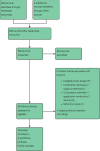Circumcision devices versus standard surgical techniques in adolescent and adult male circumcisions: a Cochrane review
- PMID: 34587354
- PMCID: PMC9297972
- DOI: 10.1111/bju.15604
Circumcision devices versus standard surgical techniques in adolescent and adult male circumcisions: a Cochrane review
Abstract
Objectives: To assess the effects of device-based circumcisions compared with standard surgical techniques in adolescent and adult males (10 years old and above).
Methods: We performed a comprehensive search with no restrictions to the language of publication or publication status. We included randomised controlled trials (RCTs) of device-based circumcisions compared to standard surgical dissection-based circumcision conducted by health professionals in a medical setting. We reported study results as risk ratios (RRs) or mean differences (MDs) using 95% confidence intervals (CIs) and a random-effects model. We used the Grading of Recommendations, Assessment, Development, and Evaluation (GRADE) approach to evaluate the overall certainty of the evidence for each outcome.
Results: A total of 18 trials met the inclusion criteria. These trials did not report severe adverse events (AEs; 11 trials, 3472 participants). There may be a slight increase in moderate AEs for devices compared to surgical techniques (RR 1.31, 95% CI 0.55-3.10; I2 = 68%; 10 trials, 3370 participants; low-certainty evidence); this corresponds to eight more (ranging from 15 fewer to 84 more) moderate AEs per 1000 participants. We are uncertain about the difference in mild AEs between groups when devices are used compared to surgical techniques (RR 1.09, 95% CI 0.44-2.72; I2 = 91%; 10 trials, 3370 participants; very low-certainty evidence).
Conclusions: We found no serious AEs using a circumcision device compared to surgical techniques. Still, they may slightly increase moderate AEs, and it is unclear whether there is a difference in mild AEs. High-quality trials evaluating this intervention are needed to provide further certainty regarding the rates of AEs. Clinicians, patients, and policymakers can use these results combined with their contextual factors to inform the best approach that suits their healthcare settings.
Keywords: #Andrology; circumcision; male; meta-analysis; systematic review.
© 2021 The Authors. BJU International published by John Wiley & Sons Ltd on behalf of BJU International.
Conflict of interest statement
Tamara Kredo is partly supported by the Research, Evidence and Development Initiative (READ‐It) project. READ‐It (Project number 300342‐104) is funded by UK aid from the UK government; however, the views expressed do not necessarily reflect the UK government’s official policies. The remaining authors declare to having no conflict of interest or external funding to disclose.
Figures
Comment in
-
Trauma, and Genital and Urethral Reconstruction.J Urol. 2022 May;207(5):1144-1147. doi: 10.1097/JU.0000000000002464. Epub 2022 Feb 10. J Urol. 2022. PMID: 35139647 No abstract available.
References
-
- World Health Organization Department of Reproductive Health and Research Joint United Nations Programme on HIV AIDS (UNAIDS) . Male Circumcision: Global Trends and Determinants of Prevalence, Safety and Acceptability. [Internet]. Geneva: World Health Organization and United Nations Programme on HIV/AIDS; 2007. [updated 2007]. Available at: https://www.who.int/reproductivehealth/publications/rtis/9789241596169/en/. Accessed July 2021
-
- World Health Organization/ United Nations Programme on HIV AIDS . Joint Strategic Action Framework to Accelerate the Scale‐up of Voluntary Medical Male Circumcision for HIV Prevention in Eastern and Southern Africa, 2012–2016. [Internet]. Geneva: World Health Organization; 2011. [updated 2011]. Available at: https://www.who.int/hiv/pub/strategic_action2012_2016/en/. Accessed July 2021
Publication types
MeSH terms
LinkOut - more resources
Full Text Sources
Medical
Research Materials
Miscellaneous



